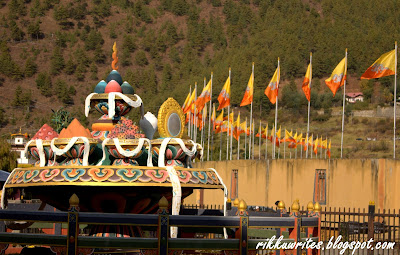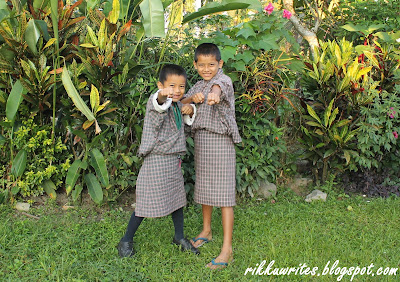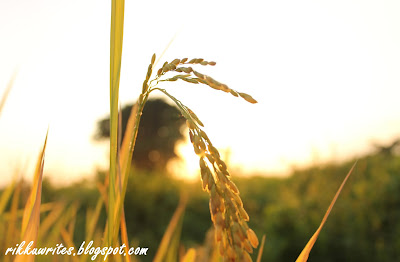Last
summer, I met Dawa in my office. Then, he had just started his teaching career
after he graduated from the Paro College of Education. I knew him for a couple
of years; he is young and highly motivated and inspired teacher.
 |
Dawa with his students
|
Out
of curiosity, I asked his placement. He replied me humbly, “I am placed at a
very remote school in Samarchen; actually, it is not even a school. It’s an extended
classroom of Sinchula Primary School.”
In
actuality, I heard the name for the first time. But he explained that his
school falls under Darla Gewog in Chukha. Samarchen lacks motor road connection
and the villagers are mostly poor. To reach his school, from the nearest motor
road at Gedu, he has to travel a 7-km farm road and then walk on foot two hours.
 |
| Classroom |
However,
what surprised me the most was when he told me that he is the lone teacher who
teaches 16 students of classes PP-2 students of the ECR. He applies the multi-grade
method of teaching.
Instead
of feeling disappointed and frustrated, he seemed very excited and motivated
about his placement and profession. This encouraged me to tell him that it was
an opportunity for him to transform the lives of the poor children by educating
them. Being a teacher is not only about teaching, but you can also contribute
to community development, I affirmed.
 |
Dawa while in Thimphu
|
At
that moment, I just uttered, “If you have any plans for your ECR, let me know. I
will help you.”
I
don’t know precisely why I said that. It worried me later, what if I cannot
fulfill the teacher’s hope. Moreover, I am not a rich man, neither am I
popular.
Dawa really trusted my words and kept hope. After that, he constantly
contacted me and shared his plans with me.
A
few months later, he came to see me in Thimphu to discuss his plans. During the
meeting, we have outlined some activities particularly to improve the living condition
of the children and ECR’s facilities. They are: 1) Reading Programme; 2)
Library Corner; 3) Distribution of Shoes; and 4) Hand washing practice.
It
is, in fact, Dawa’s passion and altruistic motivation to help his students and
the community that I started seriously looking for support from the people I
know.
One after another, I got assurance of help from my friends and
colleagues. In the meantime, my small room was almost full with books, shoes,
stationery items and soaps.
 |
| Library Corner |
Dawa
himself arranged transportation. Finally, the Samarchen got its own library
corner with a new bookshelf and books where the students can read different
books and stories. With the help of soaps, the students regularly practice the ritual
of hand washing and maintain personal sanitary.
Today,
the children have their own pair of shoes, and they wear it with smiles on
their face. For most of them, it is their first shoes. Still, Reading
Programme is yet to be organized.
 |
| Showing off their new shoes |
Recently,
Dawa told me, “The children and their parents are very happy. They are repeatedly
telling me that they want to meet you all. At least for once, they want to meet
personally and express their gratitude.”
 |
| Students practise hand washing |
It was all because of the teacher himself who had put extra effort, who assumed his
roles beyond classroom teaching that this initiative happened. If all the
teachers of Bhutan had his passion and motivation, our society would be a different
place.
He sent me this picture...
 |
| This touched me immensely! |
And for this, the following kind and compassionate individuals should be graciously thanked:
1. Tashi Namgay, Founder/Executive Director, Bhutan Kidney Foundation, for donating shoes
2. Karma Yangchen, Ministry of Education for contributing over 500 books
3. Rima Reyka, Singapore, for contributing Nu 5,000 to make a bookshelf
4. Deki Tshomo, Dy. Chief Programme Officer, MoE for contributing soaps and nursery CDs
5. Others for contributing drawing and painting materials.
Indeed, a teacher who hopes can really care and inspire change!



























































